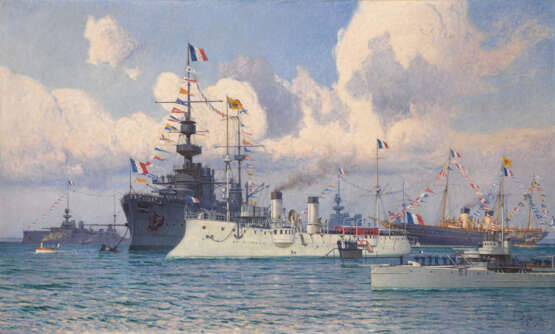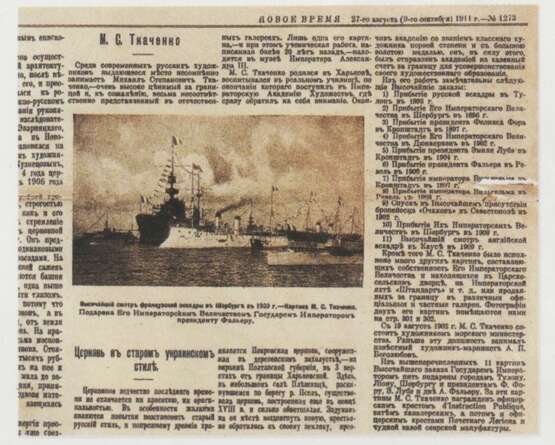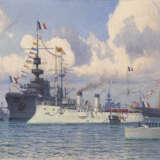ID 326888
Lot 5 | TKACHENKO, MIKHAIL
Valeur estimée
£ 80 000 – 120 000
Meeting of Tsar Nicolas II and the President of the French Republic Armand Fallieres in Cherbourg Harbour on 31 July 1909
Provenance: A gift from Tsar Nicholas II to President Fallières c. 1911.
Important private collection, Europe.
Authenticity of the work has been confirmed by the expert V. Petrov.
Literature: Novoe vremia, No. 1273, 27 August 1911, No. 10, illustrated and listed.
Mikhail Stepanovich Tkachenko. 1860–1916, Kiev, Korners, 2010, p. 134, illustrated in a published cutting from the 1911 newspaper Novoe vremia.
Mikhail Tkachenko painted the present lot in 1910. Entitled Meeting of Tsar Nicolas II and the President of the French Republic Armand Fallières in Cherbourg Harbour on 31 July 1909, it was commissioned by Nicholas II as one of several large marine pieces intended to be important gifts from the government.
The Ukrainian painter Mikhail Tkachenko had a talent that was highly prized by the imperial court under both Alexander III and Nicholas II. After graduating from the Imperial Academy of Arts, Tkachenko arrived in Paris in 1888. His studies at Cormon’s Academy opened the artist up to a new understanding of the challenges of art and acquainted him with the best painters of their day. Later he would come to know Nikolai Gritsenko and Alexei Bogoliubov, who were retained by the Russian Naval General Staff as its painters in France. It was thanks to the involvement of these artists that, in 1893, Tkachenko found himself in Cherbourg and Toulon for the first time, joining them to gather material on the visit of Russian ships to France. One outcome of this trip was the painting Russian Squadron in Toulon, a triumph for which Tkachenko was awarded the Legion d’honneur. From then on Tkachenko was considered one of the best marine artists in Europe and in 1900 this led to his appointment as Artist of the Navy and Painter to the Naval General Staff.
On July 18th 1909 (July 31st New Style) the Emperor Nicholas II arrived at Cherbourg in the Imperial Yacht Standard with the aim of signing the Franco-Russian Alliance. The ceremonial meeting with French President Armand Fallières and Minister for the Navy Boué de Lapeyrère took place on board the battleship Verité, where the Russian emperor presented a commemorative gold medal to the French president with the straightforward inscription “Former enemies – now cordial friends”. World war was to break out only a few years later, followed by revolution in Russia, and today only the pages of history and Tkachenko’s historical canvases, painted as everlasting memorials, bear witness to the serene atmosphere of entente cordiale in 1909 and represent the French fleet in full ceremonial order.
As the favourite artist of two emperors, Tkachenko’s works were often presented as diplomatic gifts in the cause of Russia’s relations with France. For this reason most of them are now held by State or private collections in France, Belgium and Ukraine and only a small proportion by the Central Naval Museum in St Petersburg, which makes this work a unique piece in the early 20th century history of Russia.
Indeed, the occasion of the Russian Tsar presenting this painting to the French President in 1911 was extensively documented in the French press. One newspaper published the following description: “A small meeting took place at 4 pm at the Palais d’Elysée, again demonstrating the closeness between France and Russia. Accompanied by Baron Shillin, the Russian Ambassador M. Izvolsky was received by President Fallières and presented the latter with a painting, a gift from the Russian Emperor. The painting is a work of a distinguished Russian artist M. Tkachenko, depicting the meeting of the Russian Tsar and M. Fallières in Cherbourg on the 31 July 1909”.
The present lot as illustrated in Novoe vremia, No. 1273, 27 August 1911, No. 10.
Extract from a French newspaper where the present lot is described.
| Adresse de l'enchère |
MacDougall Arts Ltd. 33 St James’s Square SW1Y 4JS London Royaume-Uni | ||||||||||||||
|---|---|---|---|---|---|---|---|---|---|---|---|---|---|---|---|
| Aperçu |
| ||||||||||||||
| Téléphone | +44 20 7389 8160 | ||||||||||||||
| Téléphone | +7 495 799 4683 | ||||||||||||||
| Fax | +44 (0) 20 7389 8170 | ||||||||||||||
| Commission | 27 % | ||||||||||||||
| Conditions d'utilisation | Conditions d'utilisation | ||||||||||||||
| Heures d'ouverture | Heures d'ouverture
|






